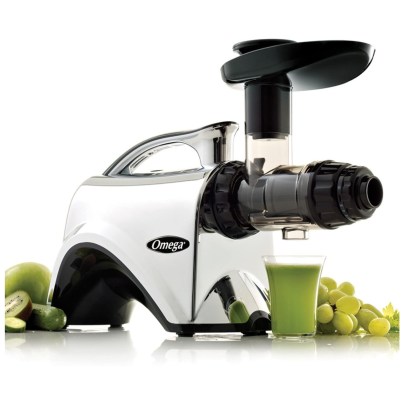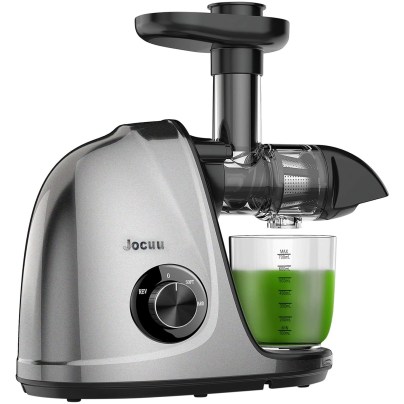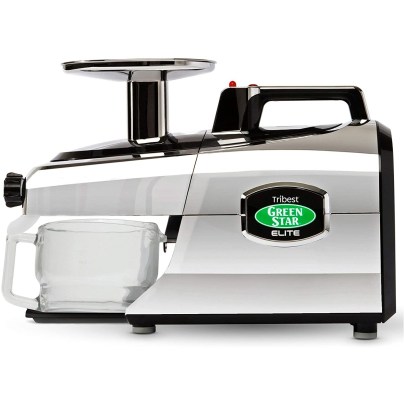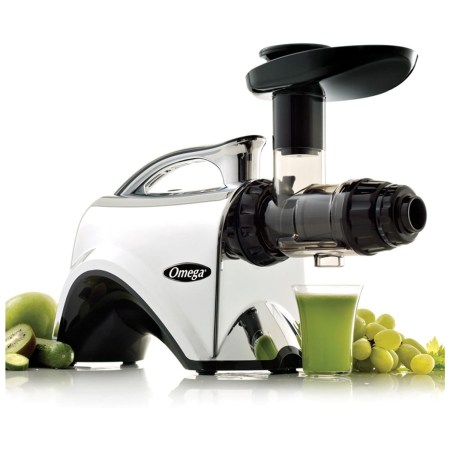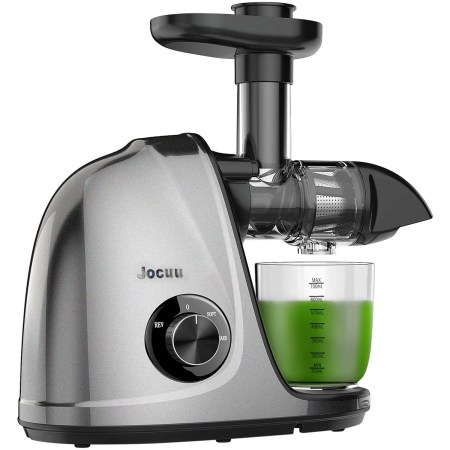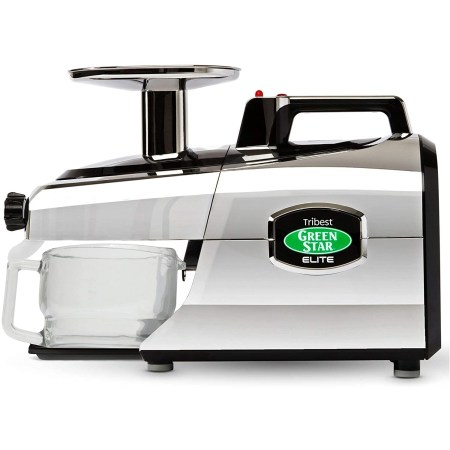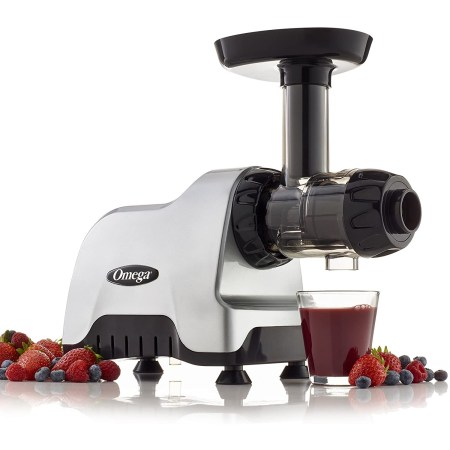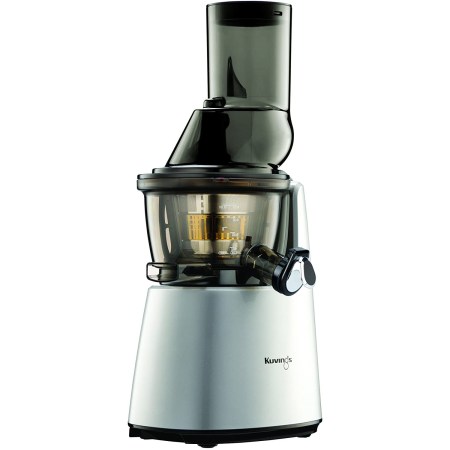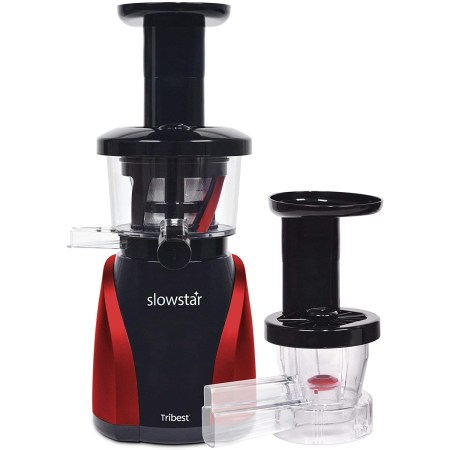We may earn revenue from the products available on this page and participate in affiliate programs. Learn More ›
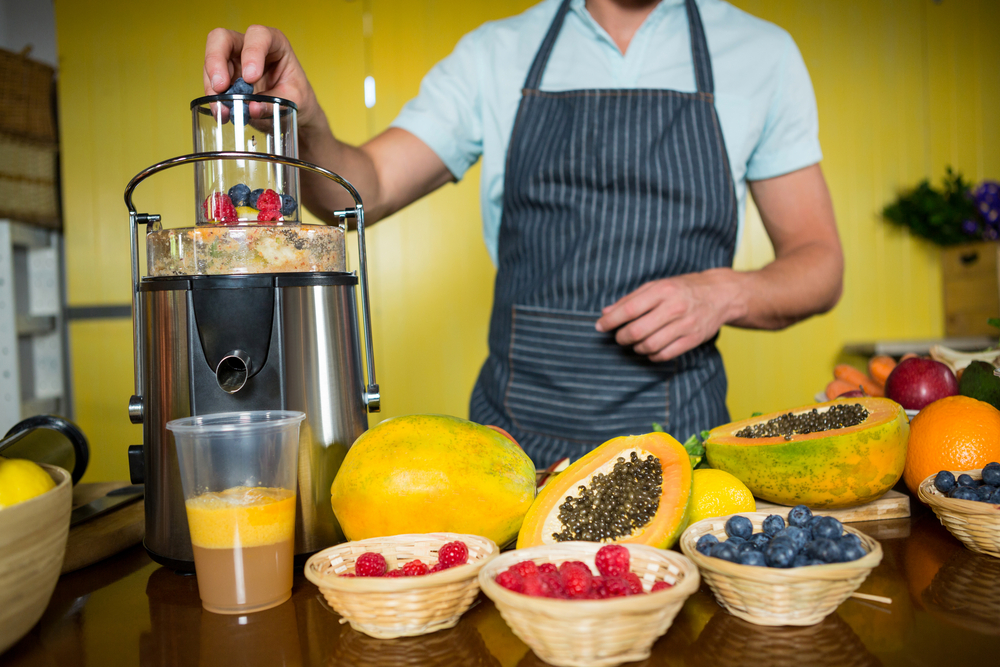
Also known as slow juicers or cold press juicers, masticating juicers are a popular tool for making fresh, nutrient-rich fruit and vegetable juice. Traditional juicers, sometimes referred to as centrifugal juicers, use high-speed blades and operate at 1,200 revolutions per minute (RPM) to extract juice from fruit and vegetables. This process produces heat, which may negatively affect temperature-sensitive nutrients. Masticating juicers use a rotating auger and operate at slower speeds of 60 to 100 RPM. This process preserves nutrients and reduces oxidation, meaning the juice will stay fresh for up to 72 hours in the fridge.
While choosing the best masticating juicer might seem like a simple decision, there are a number of considerations to weigh. This guide explores several important features to look for as you shop and offers choices by category for some of the top products on the market.
- BEST OVERALL: Omega Juicer Extractor and Nutrition System
- BEST BANG FOR THE BUCK: Jocuu Juicer Machines
- UPGRADE PICK: Tribest GSE-5050 Cold Press Masticating Slow Juicer
- BEST MULTIPURPOSE: Omega Multi-Purpose Nutrition System Juicer
- BEST EASY TO CLEAN: Kuvings Whole Slow Juicer Elite C7000S
- BEST VERTICAL: Tribest SW-2000 Slowstar
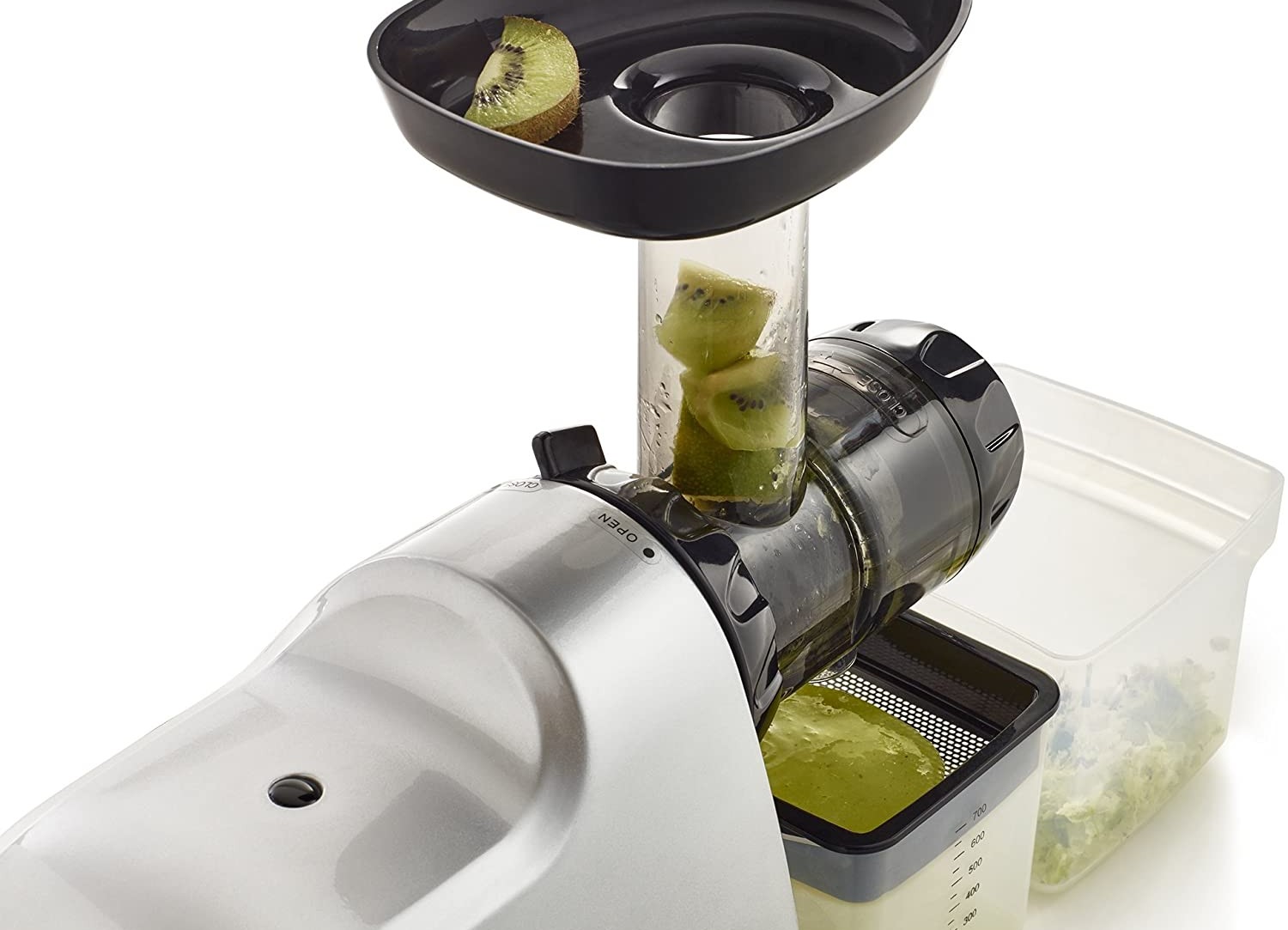
What to Consider When Choosing the Best Masticating Juicer
While it’s easy to assume all masticating juicers offer similar performance, a number of factors affect their functionality, including size, weight, capacity, power, versatility, and configuration (vertical or horizontal). Keep reading to learn about the most important features to consider when choosing a masticating juicer for your kitchen.
Size and Weight
First, consider size when shopping for a masticating juicer. Juicers are relatively large appliances and take up a significant amount of counter or cabinet space. In general, masticating juicers are even larger than their centrifugal counterparts. They also tend to be heavy, weighing between 10 and 20 pounds, so it may be a nuisance to move them from a pantry or cabinet to the counter.
Vertical juicers range in height from approximately 17 to 21 inches. There is typically 18 inches of space between kitchen countertops and upper cabinets, meaning many vertical juicers won’t fit under the cabinets.
Capacity
Slow, masticating juicers have a higher yield than traditional centrifugal juicers. Depending on the fruit or vegetable used, they can extract 15 to 20 percent more liquid, leaving dryer pulp behind.
Some juicers are sold with a plastic container to collect the juice. Personal-size containers have capacities of 8 to 16 ounces, while containers for larger juicers can hold between 32 and 40 ounces of liquid.
The size of the feed chute affects how much prep you’ll have to do in advance. Wider chutes can accommodate a whole apple, while narrow chutes require that fruit and vegetables be cut into smaller pieces before being inserted. Look for a model with a feed chute with a diameter of at least 3 inches to minimize prep time.
Power and Performance
Masticating juicers process food using an auger that rotates at slow speeds, pulling in fruit and vegetables to break them down and then press them against a fine mesh screen, separating the juice from the pulp. Some models have a dual-auger design, which provides even better performance, making the juicer faster and more energy efficient. Dual-auger systems are generally found in more expensive, high-end juicers.
While centrifugal juices rely on speed for performance and advertise high revolution speeds, masticating juicers depend on their motor power. Look for juicers that operate at RPMs of between 60 and 100 with 2-horsepower motors.
Vertical vs. Horizontal
Masticating juicers have either a vertical or horizontal configuration, each of which has its own advantages.
- Horizontal juicers use a horizontal auger and take up more counter space, but they generally offer superior performance. They’re more powerful and are best for processing leafy greens and tough, fibrous vegetables. Extra attachments can transform a horizontal juicer into a multifunctional appliance for grinding coffee beans or extruding pasta.
- Vertical juicers use a vertically positioned auger, allowing gravity to pull fruits and vegetables downward. Vertical juicers take up less counter space and have fewer removable parts, making assembly and disassembly simpler.
Versatility and Attachments
Some masticating juicers have multiple settings for juicing different fruits and vegetables. The slow speed of masticating juicers is ideal for processing leafy greens and fibrous vegetables, but faster speeds are ideal for juicing softer fruits like berries and stone fruits.
While all masticating juicers separate produce into juice and pulp, extra attachments can increase their versatility. Different nozzles are designed to create various dishes, including yogurt, nut milk, baby food, and sorbet. Some include grinding attachments that are used to grind coffee beans as well as nuts, seeds, and spices.
Additional Features
Some masticating juicers feature additional desirable features, such as:
- A small cleaning brush to remove food particles from the auger.
- Nonslip feet to ensure the juicer doesn’t slide around the counter while in use.
- A reverse function to prevent clogs and make the juicer easier to clean.
- Motor protection, which automatically stops the juicer from operating after a set period of time.
Ease of Cleaning
Juicers are notoriously tricky to clean because they feature a number of components. Expect to spend between 5 and 10 minutes disassembling the machine and cleaning all removable parts by hand. Look for models with fewer removable parts that are easy to assemble and disassemble. If ease of cleaning is a priority, consider a juicer with dishwasher-safe components.
A juice cap further increases the ease of cleaning, allowing users to run water through the machine to remove food residue. Vertical masticating juicers are easier to clean with this method because gravity pulls water through the machine.
Our Top Picks
The following recommendations take into account the abovementioned features to consider when shopping for the best masticating juicer, in addition to overall quality and value. Read on to discover some of the top options on the market in a variety of categories for making nutritious fresh juice.
Best Overall
Omega Juicer Extractor and Nutrition System
See ItThis model from Omega uses a 150-watt, 2-horsepower motor, operating at 80 RPM, and offers two screens for dual-stage masticating extraction. By offering five settings, the level of mastication can be adjusted for tougher and more fibrous vegetables. The six interchangeable nozzles make this appliance more versatile, offering the ability to make nut butter, baby food, soy or nut milk, extruded pasta, and more. Automatic pulp ejection allows for continuous juicing.
The horizontal casing’s chrome finish is easy to clean and won’t be damaged by acidic fruits or vegetables. The large feeding chute minimizes prep time. This juicer measures 14.5 by 6.5 by 15.5 inches and weighs 13 pounds.
Best Bang for The Buck
Jocuu Juicer Machines
See ItOne disadvantage of slow juicers is that they aren’t ideal for processing softer fruit like berries and citrus. This horizontal model, however, offers both a “soft” and “hard” setting, allowing users to tailor the process depending on what they’re juicing. While many juicers are noisy, this one operates quietly at 50 decibels. It also features motor protection, which stops the juicer from operating after 20 minutes to prevent overuse.
Assembly and disassembly are easy, and all removable parts are dishwasher safe. A reverse function prevents clogs and further increases the ease of cleaning.
Upgrade Pick
Tribest GSE-5050 Greenstar Elite
See ItThis Tribest slow juicer uses a dual-auger system and operates at 110 RPM for maximum juice extraction. Automatic pulp ejection allows for continuous juicing. This model also allows for pressure adjustments while the unit is in operation. Meaning, the juicing pressure can be raised or lowered depending on the fruit or vegetable being juiced.
Measuring 18.6 by 6.8 by 12.4 inches and weighing 17.2 pounds, this model likely needs to be stored on the counter. A glass juice pitcher, wooden plunger, plastic plunger, and cleaning brush are all included. The included homogenizing accessory is used for making nut butter and sorbets.
Best Multipurpose
Omega Multi-Purpose Nutrition System Juicer
See ItOmega’s multi-purpose juicer is a versatile appliance that earns its place on the countertop for the wide variety of dishes that it’s capable of preparing. The device is designed to extract juice, grind coffee beans, create nut butter, mince herbs, make frozen desserts, and extrude pasta using a variety of different nozzles. It functions at 80 RPM, using a 200-watt motor, and provides automatic pulp ejection for continuous operation.
Five nozzles, a juice filter, homogenizing filter, pulp bowl, and juice bowl are all included.
Best for Easy Cleaning
Kuvings Whole Slow Juicer Elite C7000S
See ItWhat sets this model from Kuvings apart is that it includes several cleaning brushes as well as a specialty cleaning tool designed to effectively clean the mesh screen. The detachable smart cap prevents drips and can be easily removed and rinsed between uses.
This vertical model has a powerful 240-watt motor and operates at slow speeds of 60 RPM for maximum juice extraction. At the same time, the Kevings also boasts a wide, 3-inch feeding tube that reduces prep work, allowing users to juice whole fruits and vegetables. The included sorbet attachment makes the device even more versatile.
This juicer weighs 16 pounds and measures 9 by 8 by 17.5 inches, meaning it can be tucked under most upper kitchen cabinets.
Best Space Saver
Tribest SW-2000 Slowstar
See ItVertical slow juicers have a number of benefits. For one thing, they take up less counter space. For another, they use gravity to pull ingredients into the auger.
This model from Tribest uses a 200-watt motor and operates at just 47 RPM. The double-edged auger prevents clogs and creates pulp-free juice. Use the mincing attachment for creating nut butter, sorbets, dips, or sauces. The detachable juice cap prevents leaks while switching containers and allows users to fill the juicer with water for easier cleanup.
With measurements of 7.5 by 7.5 by 17.75 inches, the Tribest can fit under standard-height upper cabinets. It weighs 19 pounds, though, so it may be too heavy for some users to move and carry without a helper.
The Advantages of Owning the Best Masticating Juicer
Masticating juicers produce nutrient-rich, cold-pressed juice that stays fresh for days.
- Juice made with a masticating juicer stays fresh for up to 72 hours when stored in the fridge.
- Masticating juicers yield 15 to 20 percent more juice.
- Masticating juicers produce less heat and preserve nutrients.
- A masticating juicer is an ideal tool for juicing leafy greens, fibrous vegetables, and wheatgrass.
- Masticating juicers are quieter than their centrifugal counterparts.
FAQs About Masticating Juicers
Ready to start juicing? For more information about masticating juicers, check out these answers to some of the most frequently asked questions.
Q. What is the difference between a centrifugal juicer and a masticating juicer?
Centrifugal juicers use high-speed blades, while masticating juicers operate at slower speeds using an auger to grind produce and press it through a sharp mesh screen.
Q. Is a masticating juicer the same as a cold press juicer?
Masticating juicers may also be called slow juicers or cold press juicers, but all three terms refer to the same type of appliance.
Q. How do I clean a masticating juicer?
Follow the cleaning instructions provided by the manufacturer. Disassemble all removable parts and wash them by hand or in the dishwasher if they are dishwasher safe.
Q. How do I store a masticating juicer?
Since masticating juicers—especially horizontal models—tend to be large, store them on the counter where they will be used. Store smaller vertical models in a cabinet.
